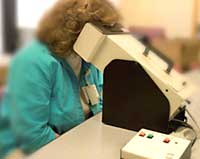Portable device yielded similar visual acuity scores as ETDRS chart in small study
The authors say community outreach clinics could benefit from the compact device, which can be operated by a layperson or a nurse.
A portable, compact device produced similar visual acuity scores as the standard Early Treatment Diabetic Retinopathy Study chart, a small prospective study found.
 Lori Ann F. Kehler |
Lori Ann F. Kehler, OD, and colleagues at the Vanderbilt Eye Institute sought to evaluate whether a device that employs a reduced Early Treatment Diabetic Retinopathy Study (ETDRS) chart can produce measurements that are comparable to a standard ETDRS chart. They published their results of the prospective, cross-sectional study in the American Journal of Ophthalmology.
The ETDRS, a type of logMAR system, is the standard measurement tool for diabetic retinal screening. The portable device, the Optec 800, uses a reduced ETDRS chart projected inside a self-contained unit. The device was designed for institutional research purposes by Stereo Optical and is not currently available on the market. According to Stereo Optical, physicians can upgrade to the Optec Functional Vision Analyzer, which has two levels of homogenous illumination and two levels of radial glare for contrast sensitivity testing that meets ANSI and ISO standards.
“Having a small desktop device that doesn’t take up any floor space has been preferable to our community outreach clinics,” Dr. Kehler told Ocular Surgery News in a telephone interview.
The Optec 800 is used by the Vanderbilt University Ophthalmic Imaging Center in its diabetic eye screening protocol at Veterans Administration hospitals and community clinics, Dr. Kehler said.
The ETDRS chart is not practical for use in screening programs because it is not compact or portable. Compact logMAR charts are in use but have fewer optotypes per line than conventional charts, the investigators said.
“A portable illuminated ETDRS chart is quite large, and it’s usually on wheels,” Dr. Kehler said. “It can be placed on a wall. However, most clinicians use it at various distances since it is a logarithmic chart, so it can be calibrated to different distances. It is used for low-vision [patients] quite often.”
The two methods
Dr. Kehler and colleagues enrolled 40 patients in the study, seven who were later excluded because of ophthalmic disease or poor cooperation. The remaining group comprised 33 patients (22 women and 11 men). The average patient age was 57.4 years (range, 19 to 90 years).
|
Image: Kehler LAF |
Patients were randomized to be tested with either the ETDRS chart or the Optec 800.
A single examiner used an external switch to shift the Optec 800 projection from the right eye to the left eye. Charts comprised different optotypes for the right and left eye. For the ETDRS chart, patients used a mask-style occluder for monocular viewing.
Patients began testing with their right eye and were directed to read each letter in a forced-choice fashion until an entire line of letters was identified incorrectly. The left eye was tested the same way. The testing sequence with each tool was repeated with the other instrument. Researchers calculated a total correct score for each eye on each test, according to the study.
“There’s not an eye care practitioner giving the test. It is given by a layperson usually or by a nurse,” she added.
Researchers used the Wilcoxon signed rank test and two-tailed t-test to analyze patients’ scores. Data showed no statistically significant difference between scores with the Optec 800 and ETDRS chart, they said.
ANOVA variance analysis showed that neither gender nor testing order influenced performance. Also, the data showed no statistically significant adaptation or fatigue trend between the right eye tested first and the left eye. Regression analysis showed a weak inverse relationship between age and performance, the authors reported.
Effect of refractive error
The authors suggested that clinicians and researchers study the influence of refractive correction on the performance of the Optec 800. Some literature has suggested that widespread refractive error may affect test-retest reliability, Dr. Kehler told OSN.
“Test-retest reliability is a measure of whether or not the same patient can produce the same result two times in a row,” Dr. Kehler said. “Anecdotally, our clinicians have not had that experience but because this has been reported in the literature, we think that it is appropriate to evaluate at some point.”
Also, the Optec 800 should not be used to evaluate children because of the difficulty of taking the test, she said.
“I think for general vision screening, the instrument is quite useful, but only for adults and for those without severe vision impairment,” she said. “If severe vision impairment is present, it would be quite difficult for an adult to complete the test.”
For more information:
- Lori Ann F. Kehler, OD, can be reached at Vanderbilt Eye Institute, 1215 21st Ave. South, 8000 MCE, North Tower, Nashville, TN 37232; 615-591-3065: fax: 615-936-1492; e-mail: lori.kehler@vanderbilt.edu. Dr. Kehler and colleagues do not have a financial interest in the products or devices mentioned in this article.
- Stereo Optical, maker of the Optec 800, can be reached at 3539 N. Kenton Ave., Chicago, IL 60641; 773-777-2869; fax: 773-777-4985; Web site: www.stereooptical.com.
Reference:
- Kehler LF, Kehler KB, Merin LM, Tsai JC. A portable visual acuity device used in diabetic retinal screening. Am J Ophthalmol. 2007;143:514-515.
- Matt Hasson is an OSN Staff Writer who covers all aspects of ophthalmology. He focuses on regulatory, legislative and practice management topics.

